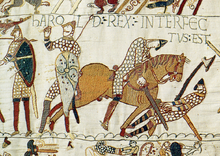Reading Museum
 The entrance to the Reading Museum within Reading Town Hall | |
| Established | 1883 |
|---|---|
| Location | Reading, Berkshire, UK |
| Coordinates | 51°27′26″N 0°58′13″W / 51.4572°N 0.9702°W |
| Type | Local museum |
| Public transit access | Reading railway station |
| Website | readingmuseum.org.uk |
Reading Museum (run by the Reading Museum Service) is a museum of the history of the town of Reading, in the English county of Berkshire, and the surrounding area. It is accommodated within Reading Town Hall, and contains galleries describing the history of Reading and its related industries, a gallery of artefacts discovered during the excavations of Calleva Atrebatum (Silchester Roman Town), a copy of the Bayeux Tapestry, finds relating to Reading Abbey and an art collection.[1]
History of the museum
Reading Town Hall was built in several phases between 1786 and 1897, although the principal facade was designed by Alfred Waterhouse in 1875. In 1879, the foundation stone was laid for a new wing containing a library and museum, and the museum duly opened in 1883. Three art galleries were added in further extension in 1897.[2]
In 1975, the civic offices moved out of the Town Hall, to Reading Civic Centre followed in 1985 by the Reading Central Library, leaving only the museum and concert hall in use. After some debate, plans to demolish the Town Hall and replace it with a new cultural centre were dropped, and in 1986 refurbishment of the building started. The museum was closed for renewal in 1989, reopening in stages from 1993 (the Reading: People & Place gallery) to 2000.
Principal galleries
The Reading: People & Place gallery documents Reading's history, from its origins as a Saxon settlement in the 6th century up to today, with a mixture of oral history presentations, interactive displays and a mix of real objects from the period. There is an emphasis on Reading Abbey.
The Silchester Gallery features many archeological finds from the excavations conducted at the nearby Calleva Atrebatum (Silchester Roman Town) together with explanatory models and other information on life in the Roman town. This includes the bronze Silchester Eagle that was immortalized by Rosemary Sutcliff in her children’s book The Eagle of the Ninth.

The Bayeux Gallery contains the UK's only copy of the famous Bayeux Tapestry, made in 1885, together with information on the history of Saxon migration and Viking raids in the local area.[3]
The Green Space explains the geology and natural history of the Reading area, with a wide range of specimens.
The Huntley & Palmers Gallery explains the history of the biscuit-making industry that was once one of the mainstays of the Reading economy, with special emphasis on the Huntley and Palmers company.
The Windows Gallery displays the museum's collection of sculpture and decorative art, ranging from 12th century pieces from Reading Abbey to modern pieces by Rodin and Epstein.
The John Madejski Art Gallery is a recreation of the museum's original Victorian era art gallery and houses changing exhibitions of artworks. It is named after John Madejski, the chairman of Reading F.C..
The Exhibition Gallery houses changing exhibitions, both from the museum's collection and external sources. As an example, in late 2004, the gallery contained an exhibition on the history of the Reading Festival.
Access
The museum is free to visit. As of June 2017, it is open from 10:00 to 16:00 on Tuesday to Saturday, and closed all day Monday and Sunday, with exceptions for holidays.
References
- ^ Reading Museum, Culture24, UK.
- ^ "Reading Town Hall (townhall-36.pdf)". Reading Museum Service. Retrieved 2015-10-02.
- ^ Britain's Bayeux Tapestry at the Reading Museum, Reading Museum Service, Reading Borough Council, UK.

